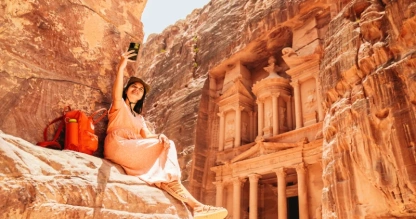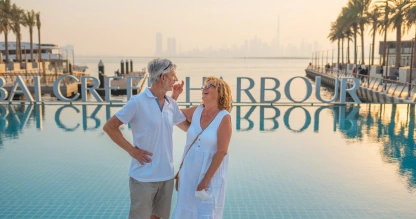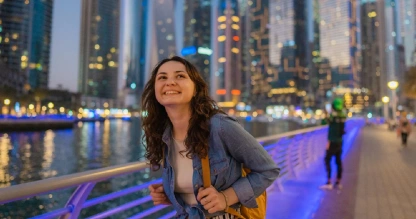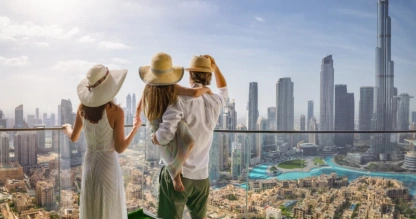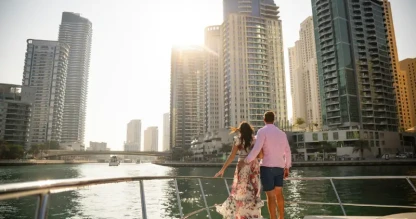
Explore the Historic Al Fahidi Fort in Dubai
Dubai's Al Fahidi Fort, built in 1787, remains the city's oldest standing building. This remarkable structure now houses Dubai's most popular museum and welcomes about 2,000 visitors each day.
The fort's story spans centuries as it transformed from a defensive stronghold to a palace and later a prison. Dubai experienced rapid modernization in the 1970s, yet this historical treasure remained untouched. The year 1971 marked two significant events - the formation of the United Arab Emirates and the fort's transformation into the Dubai Museum.
Visitors can discover Dubai's rich heritage at this cultural landmark, nestled in the Al Fahidi Historical Neighborhood, during their Dubai tours. The museum's extensive collection includes artifacts from as far back as 3000 BC. Beyond Dubai's modern skyline and contemporary attractions, the fort gives visitors a genuine perspective of the region's cultural heritage and historical evolution.
History of Al Fahidi Fort
Al Fahidi Fort's story began around 1787 with the construction of its oldest tower, making it Dubai's earliest surviving structure.
Construction and Founding
The Fort was built using local materials that showed remarkable creativity. The builders employed coral rocks, mud bricks, and mortar, and some parts had coral and shells held together with lime. A slim round watch tower came first, and the builders added a larger structure in 1799.
Strategic Role in Defense
The fort stood at urban Dubai's original border and protected the town from potential invaders. Its main goal was to guard the landward approaches against raids from neighboring tribes. The fort's design matched military strategies of that time, with high walls and watchtowers that gave defenders clear views of the surroundings. The fort's location near Dubai Creek—the town's main trade route and income source—made it perfect for protecting the growing community.
Evolution Over Time
Al Fahidi Fort played many roles beyond defense. The ruling family lived here until 1896, and it served as the government's headquarters. Later, the fort became a weapons arsenal and artillery storage. The fort also served as a prison for outlaws before the UAE's formation
Transformation into Dubai Museum
Sheikh Hamdan Bin Rashid Al Maktoum took steps to preserve this historical treasure in 1969 by asking Kuwait for museum expertise. Sheikh Rashid bin Saeed Al Maktoum led extensive restoration work. The fort opened as Dubai Museum in 1971—the same year the United Arab Emirates formed. The museum's main goal was to show Dubai's traditional lifestyle before oil changed everything. An underground extension added in 1995 displays pre-oil era exhibits and archeological findings, making the visitor's experience richer while preserving Dubai's cultural heritage.

Architecture and Design
Al Fahidi Fort stands as a testament to traditional Gulf defensive architecture. Its design has endured Dubai's harsh climate for centuries. The fort demonstrates remarkable creativity in building a comfortable space using only local materials.
Building Materials and Structure
The fort's impressive walls came from coral rock and shells held together with lime mortar. These green materials naturally insulated the building and created a pleasant environment despite the desert heat. The structure also incorporated:
- Solid teak and iron nails for support
- Gypsum and palm wood for interior features
- Brass plates as decorative elements
- Palm fronds in traditional Arish sections
The fort's exterior shows thick defensive walls in a distinctive square shape. The barjeel (wind towers) remains one of its most remarkable architectural features. These towers worked as a natural cooling system that channeled breezes into the fort's interior.
Layout of the Fort
The fort's ground plan takes a square shape with three unique towers. Two round towers sit at opposite corners while a rectangular one occupies a third corner. A central courtyard acts as the complex's heart and houses a traditional summer house (Arish) built from woven palm fronds.
Two traditional cannons and the flags of Dubai and the United Arab Emirates greet visitors at the east entrance. Museum halls line three of the fort's walls, and additional galleries stretch beneath the courtyard.
The fort's design reflects Arabian values through its architecture. High, narrow windows show the importance of privacy in traditional Emirati building practices. The lack of front-facing windows further emphasizes this cultural value.
Restoration Efforts
The fort went through major restoration under Sheikh Rashid bin Saeed Al Maktoum before opening as Dubai Museum in 1971.
The current Al Fahidi Rehabilitation Project takes an innovative approach while respecting the fort's heritage. A minimalist, recessed structure combines smoothly with its surroundings. This work will improve access, update infrastructure, and create better public spaces around the fort.
The renovated museum will soon let visitors experience this iconic structure's architectural beauty and cultural story. This restoration reflects Dubai’s commitment to preserving its history while embracing modernity — a must-see highlight included in many Dubai travel packages.

Exhibits and Attractions Inside
Dubai Museum at Al Fahidi Fort welcomes visitors with a wealth of exhibits that take them on a journey through time. The museum opened in 1971 and wants to show how people lived in Dubai, giving visitors a detailed view of the region's rich history.
Historical Artifacts
The museum holds rare artifacts that tell Dubai's story of rise. The pearl diving exhibit stands out with weights, sieves, and scales that pearl merchants once used—showing how this industry drove Dubai's economy before oil was discovered. The Fortification Wing lets visitors see ancient weapons like spears, curved daggers, shields, and pistols that protected the region. The Oasis Wing shows off items made from copper, mud, and alabaster that prove early settlers' craftsmanship.
Traditional Life Displays
Life-size dioramas make up the core of what visitors experience, bringing old Dubai to life. The main exhibition area shows realistic scenes of daily life with a busy creek-side souq where craftsmen work. Visitors walk through perfectly recreated Arab houses, mosques, and traditional date farms. A Bedouin tent in the desert life diorama holds jewelry, trinkets, and everyday items, next to displays of camels and local wildlife.

Archeological Findings
The archeological section holds items from 3000 BC that give an explanation of how ancient people lived. A special diorama shows the Al Qusais archeological site with its excavated tombs and skeletal remains. Display cabinets throughout show artifacts from different time periods, including items from Jumeirah's Umayyad site that help tell Dubai's ancient story.
Cultural Showcases
The museum goes beyond artifacts to celebrate trade connections through items from African and Asian countries. The maritime wing—the biggest diorama—shows how boats were built and displays seafaring tools. Hologram-like videos and sound effects create a real experience throughout the museum. Interactive displays show Dubai's journey from Bedouin life to modern times, telling the story of a city that changed forever.

Guide to Visiting Al Fahidi Historical District
Location
Al Fahidi Fort stands proudly at the heart of Dubai's historic district, right in the middle of the charming Al Fahidi Historical Neighborhood along Dubai Creek. The fort's location makes it easy to visit -several bus routes stop close by at Heritage Village and Dubai Museum.
Opening Hours
The fort opens its doors to visitors from Saturday through Thursday, 8:30 AM to 8:30 PM. Friday visits start later at 2:30 PM and continue until 8:30 PM. Ramadan brings different hours - the fort welcomes guests from 10:00 AM to 5:00 PM, Sunday to Thursday.
Best Time to visit
Dubai's weather makes the fort most enjoyable between November and March. Temperatures stay pleasant at 18°C to 28°C, which creates perfect conditions to learn about the outdoor spaces. Visitors who want a quieter experience should plan their visit early on weekdays, before 10:00 AM.
Nearby attractions
The area around the fort has plenty to offer. Dubai Creek sits nearby, where you can hop on a traditional abra ride. Al Seef's waterfront development blends old-world charm with contemporary design. Sheik Saeed Al Maktoum House stands a short walk away. This historic building gives visitors another window into Dubai's rich heritage.
Visitor Tips
Wear light, comfortable clothing and shoes, as you’ll spend time walking through narrow lanes and open courtyards. Visit early in the morning or late afternoon to avoid the midday heat. Entry to the district is free, but small museums and cultural centers may charge a modest fee. Bringing a camera is a must — the wind towers, sand-colored walls, and old wooden doors make for beautiful photos.
Discover the wonders of Dubai with our Dubai Tours and the best of Middle East trips!

FAQs
Q1. Where is Al Fahidi Fort?
Al Fahidi Fort is located in the heart of Bur Dubai, one of the city’s oldest neighborhoods. It sits near the Dubai Creek, close to the Al Fahidi Historical District.
Q2. When was Al Fahidi Fort built?
The fort was constructed in 1787, making it the oldest existing building in Dubai. Originally built as a defensive structure to protect the settlement, it later served as a residence for the ruler and a seat of government before becoming the Dubai Museum.
Q3. What to see in Al Fahidi?
Visitors can explore traditional Emirati artifacts, old weapons, archaeological findings, and life-size dioramas showing Dubai’s past as a fishing and pearl-diving village. The fort’s courtyard and towers also offer great photo opportunities and a glimpse into early Dubai architecture.
Q4. Why is Al Fahidi Fort important?
Al Fahidi Fort is a symbol of Dubai’s transformation — from a small trading post to a global metropolis. It preserves the city’s history and culture, allowing visitors to experience how life was before the oil era.
Q5. How long does it take to visit Al Fahidi Fort?
A typical visit lasts around 45 minutes to an hour. It’s best enjoyed when combined with a stroll through the nearby Al Fahidi Historical District, where you can explore art galleries, heritage houses, and cafés.

